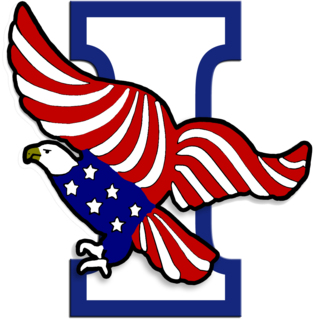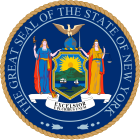Electoral fusion in the United States is an arrangement where two or more U.S. political parties on a ballot list the same candidate, allowing that candidate to receive votes on multiple party lines in the same election.
Elections in the United States have rules and procedures regulating the conditions under which a candidate, political party, or ballot measure is entitled to appear on voters' ballots. As election processes are decentralized by Article I, Section 4, of the United States Constitution, ballot access laws are established and enforced by the states. As a result, ballot access processes may vary from one state to another. State access requirements for candidates generally pertain to personal qualities of a candidate, such as: minimum age, residency, and citizenship. Additionally, many states require prospective candidates to collect a specified number of qualified voters' signatures on petitions of support and mandate the payment of filing fees before granting access; ballot measures are similarly regulated. Each state also regulates how political parties qualify for automatic ballot access, and how those minor parties that do not can. Fundamental to democracy, topics related to ballot access are the subject of considerable debate in the United States.

The New York State Right to Life Party was a minor anti-abortion American political party that was active only in the state of New York and was founded to oppose the legalization of abortion in New York State in 1970.

The Independence Party is a political party in the U.S. state of New York. The party was founded in 1991 by Gordon Black, Tom Golisano, and Laureen Oliver and acquired ballot status in 1994. They lost their ballot status in 2020 under a change in the New York state election law that required at least 130,000 votes on the party line every two years. Although often associated with Ross Perot, as the party came to prominence in the wake of Perot's 1992 presidential campaign, it was created prior to Perot's run. In 2020, it affiliated with the Alliance Party, but disaffiliated in 2021. It used to have one elected member of the New York State Assembly, Fred Thiele, until Thiele switched his party affiliation to the Democratic Party in 2022. On December 9, 2022, New York governor Kathy Hochul signed S1851A, banning the use of the words "Independent" and "Independence" from use in political party names in New York state.

The 2006 Texas gubernatorial election was held on November 7, 2006, to elect the governor of Texas. The election was a rare five-way race, with incumbent Republican Governor Rick Perry running for re-election against Democrat Chris Bell and Independents Carole Keeton Strayhorn and Kinky Friedman, as well as Libertarian nominee James Werner.

The Libertarian Party of New York (LPNY), is the affiliate of the Libertarian Party in the U.S. state of New York. Due to changes in New York State election law in 2020, the Libertarian Party lost its ballot status. It is the recognized affiliate of the national Libertarian Party.

The Libertarian Party of New Hampshire (LPNH) is the New Hampshire affiliate of the national Libertarian Party (LP). Active since its foundation in 1972, it is the third-largest political party in the state having had multiple members elected to the New Hampshire House of Representatives as well as being ballot-qualified multiple times.

The 2010 New York gubernatorial election was held on Tuesday, November 2, 2010. Incumbent Democratic Governor David Paterson, elected as lieutenant governor in 2006 as the running mate of Eliot Spitzer, initially ran for a full term but dropped out of the race. Democratic New York Attorney General Andrew Cuomo defeated Republican Carl Paladino to become the next governor of New York.

The 2010 South Carolina gubernatorial election took place on November 2, 2010. Incumbent Republican Governor Mark Sanford was term limited and unable to seek re-election. Primary elections took place on June 8, 2010, and a runoff election, as was necessary on the Republican side, was held two weeks later on June 22.

The Arizona Libertarian Party (AZLP) is the Arizona affiliate of the national Libertarian Party (LP) and has been active since its foundation on October 7, 1972.

The Libertarian Party of North Carolina (LPNC) is the North Carolina affiliate of the Libertarian Party.

The 2010 Texas gubernatorial election was held on Tuesday, November 2, 2010, to elect the governor of Texas. Incumbent Republican Governor Rick Perry ran successfully for election to a third consecutive term. He won the Republican primary against U.S. Senator Kay Bailey Hutchison and political newcomer, Debra Medina. The former mayor of Houston, Bill White, won the Democratic nomination. Kathie Glass, a lawyer from Houston and previous candidate for Texas Attorney General, won the Libertarian nomination. Deb Shafto was the nominee of the Texas Green Party. Andy Barron, an orthodontist from Lubbock, was a declared write-in candidate.
The Reform Party of New York State was the New York branch of the Reform Party of the United States of America. The branch was founded in 2000 after the Independence Party of New York, which had been affiliated with the national Reform Party from 1994 to 2000, severed ties with the national party.

The Libertarian Party of Virginia (LPVA) is the Virginia affiliate of the Libertarian Party. The party was originally founded in 1974 and was dissolved by the State Central Committee on September 11, 2022. Subsequently, the Virginia Libertarians quickly recreated the Libertarian Party of Virginia and received the recognition of the Libertarian National Committee. Some of the disaffected former Libertarians went on to create a new party, the Liberty Party – a party affiliated with the Association of Liberty State Parties.

The 2014 New York gubernatorial election took place on November 4, 2014. Incumbent Democratic Governor Andrew Cuomo sought re-election to a second term in office, though incumbent Lieutenant Governor Robert Duffy did not seek re-election. Cuomo and his running mate, former U.S. Representative Kathy Hochul, won contested primaries, while Republican Rob Astorino, the Westchester County Executive, and his running mate were unopposed for their party's nomination. Astorino and Moss were also cross-nominated by the Conservative Party and the Stop Common Core Party.

The 2018 New York gubernatorial election occurred on November 6, 2018. Incumbent Democratic Governor Andrew Cuomo won re-election to a third term, defeating Republican Marc Molinaro and several minor party candidates. Cuomo received 59.6% of the vote to Molinaro's 36.2%.
The Montana Green Party is a state-level political party affiliated with the Green Party of the United States. It formed in 2001–2002 following Ralph Nader's run for president in 2000 as the Green Party nominee.

Larry David Sharpe is an American business consultant, entrepreneur, political activist, and podcaster. He was a candidate for the Libertarian Party nomination for vice-president of the United States in 2016, losing to former Massachusetts governor Bill Weld. Sharpe was the Libertarian nominee for Governor of New York in the 2018 gubernatorial election. He again received that party's gubernatorial nomination for the 2022 New York gubernatorial election, but did not meet the qualifications to be listed on the general election ballot and consequently ran as a write-in candidate.

The Serve America Movement (SAM) was a big tent political organization founded in 2017 by Morgan Stanley lawyer Eric Grossman. The party achieved its first state party in New York with ballot access, but as of November 4, 2021, it lost its ballot status. Under New York election law, parties must get more than 130,000 votes every two years to maintain ballot access. Party officials said afterward they intended to surpass the state elections vote requirement and use petitions to gain ballot access in other states, in order to contest future elections.

Elections are held in Syracuse, New York to election the city's mayor. Currently, these elections are regularly scheduled to be held once every four years, with the elections taking place in the off-year immediately after United States presidential election years.

















